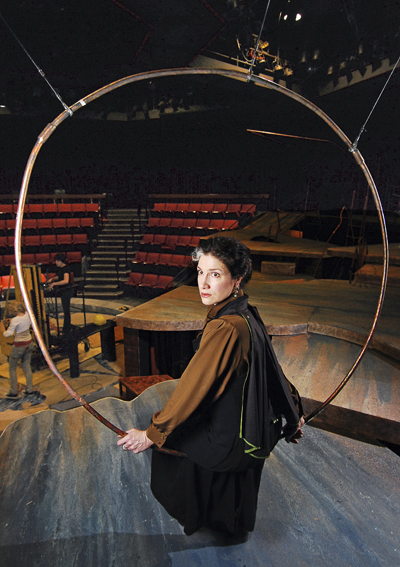Behind the scenes of “Hamlet:” post-apocalyptic costumes

MFA acting candidate Melissa Owens shows off the costume for Horatio that she will wear in the School of Theatre and Dance’s production of Hamlet. Photo by Matt Hafley.
April 15, 2011
Read: Shakespeare’s ‘Hamlet’ reinvented for modern-day audience
A student asks if the military jacket she just added buttons to looks good and is given a suggestion for how to sew a second set of buttons on. Another student asks if the patches she made look OK as a sewing machine buzzes in the background.
Dave Burrington, costume designer for “Hamlet,” enthusiastically shows off a variety of outfits the costume crew created as he answers questions and works on the final touches of a hat.
Kent’s production of Hamlet
Show times:
- April 15, 16 at 8 p.m.
- April 17 at 2 p.m.
- April 19-23 at 8 p.m.
Where: Wright-Curtis Theatre in the Music and Speech Center
Costs: $8 with student ID, $12 faculty, staff, alumni & seniors, $16 adults
These are the final scenes in the costume shop during the last week of preparation before the curtain opens on the School of Theatre’s production of “Hamlet” Friday at 8 p.m.
“This is a very conceptual show,” said Burrington, also a graduate costume design student. “It’s supposed to be a post-apocalyptic version of the world in the future.”
He said in this futuristic world, something geographically happened to the land. It could only be used for food and not the growth of wool and cotton for clothing.
“What Dave has done is taken clothes that are modern right now and reused them,” said Molly Knight, junior theatre studies major and assistant to Burrington. “It’s post-war and things are falling apart so the people are reusing and recycling.”
Burrington said there are six or seven costumes that were made from scratch. The pieces were created for the royalty in “Hamlet” because the characters would be able to buy new clothing. The starving artists in the play inspired the fashion, even some of the pieces the royalty wears. He said there are about 30 costumes created from existing pieces of clothes.
He showed off a vest made from pants, a shirt with dress shirt cuff details, a military jacket with multiple lapels and many more costumes crafted from numerous parts of old clothing.
Knight said it has been interesting to see Burrington take old dress shirts and make them into dresses and completely new clothing. Queen Gertrude’s dress replicates dress shirts with sequence detail to follow the fashion while showing off her status.
“The clothes speak and express characteristics of the characters,” Burrington said.
View Kent State Music and Speech Center in a larger map
He said he found out he’d be doing the costumes a year ago and started thinking of ideas over the summer. Then, he started playing around with shirt bits and how they would fit together.
Burrington said the play is very progressive with gender-blind casting that resulted in three women playing roles that are typically played by men and Hamlet being a Muslim. He said the progressive nature of the play shaped his costume designs, like the wrap skirt he made for Hamlet.
“The costumes kind of look like what we wear now, but all mixed up,” Knight said.
Burrington said they didn’t start creating the costumes until the beginning of the semester. He said they mainly had to purchase shoes and shirt bits and that there was little material waste. He added that the designers want to present something that is normal in a different way.
“We want to make the familiar seem strange with that little touch of alienation,” Burrington said. “It is making people examine things they normally wouldn’t examine.”
Contact Brooke Bower at [email protected].
























